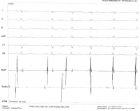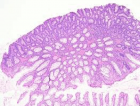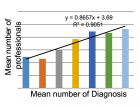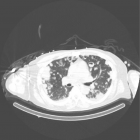Abstract
Case Report
An unusual presentation of atrioventricular nodal reentrant tachycardia
Mihaela Grecu*, Florina-Adriana Ghitun, Stefan Ailoaei, Dan Ursu, Raluca Chistol, Grigore Tinica and Cristian Statescu
Published: 12 February, 2021 | Volume 6 - Issue 1 | Pages: 014-018
Introduction: Atrioventricular nodal reentrant tachycardia (AVNRT) is the most frequent supraventricular tachycardia, commonly manifesting as autolimited paroxysmal episodes of rapid regular palpitations that exceed 150 beats per minute (bpm), dizziness and pounding neck sensation.
Case presentation: We present a case of a male patient, 70 years old, with ischemic heart disease and slow-fast AVNRT treated with radiofrequency catheter ablation (RFCA) in March 2019, with regular 6-months follow-ups. He was readmitted in our department in November 2020 for rest dyspnea and incessant fluttering sensation in the neck, without palpitations. The event electrocardiogram (ECG) was initially interpreted by general cardiologist as accelerated junctional rhythm, 75 bpm. Due to the persistence of symptoms and ECG findings, a differential diagnosis between reentry and focal automaticity was imposed. The response to vagal maneuvers and Holter ECG monitoring characteristics provided valuable information. We suspected recurrent slow ventricular rate typical AVNRT, which was confirmed by electrophysiological study and we successfully performed the RFCA of the slow intranodal pathway.
Conclusion: AV nodal reentry tachycardia may have an unusual presentation, occurring in elder male patients with structural heart disease. Antiarrhythmic drugs can promote reentry in this kind of patients. In cases of slow ventricular rate, vagal maneuvers and Holter ECG monitoring can help with the differential diagnosis. The arrhythmia can be successfully treated with RFCA with special caution regarding the risk of AV block.
Read Full Article HTML DOI: 10.29328/journal.jccm.1001110 Cite this Article Read Full Article PDF
Keywords:
Atrioventricular node; Reentry; Radiofrequency ablation
References
- Katritsis DG, Camm AJ. Classification and differential diagnosis of atrioventricular nodal re-entrant tachycardia. Europace. 2006; 8: 29–36. PubMed: https://pubmed.ncbi.nlm.nih.gov/16627405/
- Nikolaidou T, Aslanidi OV, Zhang H, Efimov IR. Structure-function relationship in the sinus and atrioventricular nodes. Pediatr Cardiol. 2012; 33: 890-899. PubMed: https://pubmed.ncbi.nlm.nih.gov/22391764/
- Hucker WJ, McCain ML, Laughner JI, Iaizzo PA, Efimov IR. Connexin 43 expression delineates two discrete pathways in the human atrioventricular junction. Anat Rec (Hoboken). 2008; 291: 204-215. PubMed: https://pubmed.ncbi.nlm.nih.gov/18085635/
- Katritsis DG, Efimov IR. Cardiac connexin genotyping for identification of the circuit of atrioventricular nodal re-entrant tachycardia. Europace. 2018; 21: 190-191. PubMed: https://pubmed.ncbi.nlm.nih.gov/29860485/
- Katritsis DG, Camm AJ. Atrioventricular nodal reentrant tachycardia. Circulation. 2010; 122: 831-840. PubMed: https://pubmed.ncbi.nlm.nih.gov/20733110/
- Porter MJ, Morton JB, Denman R, Lin AC, et al. Influence of age and gender on the mechanism of supraventricular tachycardia. Heart Rhythm. 2004; 1: 393–396. PubMed: https://pubmed.ncbi.nlm.nih.gov/15851189/
- Gonzalez-Torrecilla E, Almendral J, Arenal A, Atienza F, Atea LF, et al. Combined evaluation of bedside clinical variables and the electrocardiogram for the differential diagnosis of paroxysmal atrioventricular reciprocating tachycardias in patients without pre-excitation. J Am Coll Cardiol. 2009; 53:2353–2358. PubMed: https://pubmed.ncbi.nlm.nih.gov/19539146/
- Liuba I, Jönsson A, Säfström K, Walfridsson H. Gender-related differences in patients with atrioventricular nodal reentry tachycardia. Am J Cardiol. 2006; 97: 384-388. PubMed: https://pubmed.ncbi.nlm.nih.gov/16442401/
- Page RL, Joglar JA, Caldwell MA, Calkins H. Conti JB, et al. Evidence Review Committee Chair‡. 2015 ACC/AHA/HRS Guideline for the Management of Adult Patients with Supraventricular Tachycardia: Executive Summary: A Report of the American College of Cardiology/American Heart Association Task Force on Clinical Practice Guidelines and the Heart Rhythm Society. Circulation. 2016; 133: e471-505. PubMed: https://pubmed.ncbi.nlm.nih.gov/26399662/
- Grecu M, Floria M, Arsenescu-Georgescu C. Abnormal Atrioventricular Node Conduction and Atrioventricular Nodal Reentrant Tachycardia in Patients Older Versus Younger Than 65 Years of Age. Pacing Clin Electrophysiol. 2009; 32: S98-100. PubMed: https://pubmed.ncbi.nlm.nih.gov/19250123/
- Pentinga ML, Meeder JG, Crijns HJ, de Muinck GM, Wiesfeld ED, et al. Late onset atrioventricular nodal tachycardia. Int J Cardiol. 1993; 38: 293-298. PubMed: https://pubmed.ncbi.nlm.nih.gov/8463010/
- Evrengul H, Alihanoglu YI, Kilic I, Yildiz S, Kose S. Clinical and electrophysiological characteristics of the patients with relatively slow atrioventricular nodal reentrant tachycardia. J Interv Card Electrophysiol. 2014; 40: 117–123. PubMed: https://pubmed.ncbi.nlm.nih.gov/24793102/
- Vijayaraman P, Alaeddini J, Storm R, Oren J, Wood MA, et al. Slow Atrioventricular Nodal Reentrant Arrhythmias: Clinical Recognition, Electrophysiological Characteristics, and Response to Radiofrequency Ablation. Journal of Cardiovascular Electrophysiology 2007; 18: 950-953. https://pubmed.ncbi.nlm.nih.gov/17666062/
- Wellens HJJ, Brugada P, Abdollah H. Effect of amiodarone in paroxysmal supraventricular tachycardia with or without Wolff-Parkinson-White syndrome. Am Heart J. 1983; 106: 876-880. PubMed: https://pubmed.ncbi.nlm.nih.gov/6613833/
- Katritsis DG, Josephson ME. Differential diagnosis of regular, narrow-QRS tachycardias. Heart Rhythm. 2015; 12: 1667-1676. PubMed: https://pubmed.ncbi.nlm.nih.gov/25828600/
- Smith GD, Fry MM, Taylor D, Morgans A, Cantwell K. Effectiveness of the Valsalva Manoeuvre for reversion of supraventricular tachycardia. Cochrane Database Syst Rev. 2015; 2:CD009502. PubMed: https://pubmed.ncbi.nlm.nih.gov/25922864/
- Lim SH, Anantharaman V, Teo WS, Goh PP, Tan ATH. Comparison of treatment of supraventricular tachycardia by Valsalva maneuver and carotid sinus massage. Ann Emerg Med. 1998; 31: 30-35. PubMed: https://pubmed.ncbi.nlm.nih.gov/9437338/
- Smith G, Morgans A, Boyle M. Use of the Valsalva manoeuvre in the prehospital setting: a review of the literature. Emerg Med J. 2009; 26: 8-10. PubMed: https://pubmed.ncbi.nlm.nih.gov/19104086/
- Green M, Heddle B, Dassen W, Wehr M, Abdollah H, et al. Value of QRS alteration in determining the site of origin of narrow QRS supraventricular tachycardia. Circulation. 1983; 68: 368-373.
- Silva RMF, Roever L. Typical atrioventricular nodal reentrant and orthodromic atrioventricular tachycardias: electrocardiographic, electrophysiological diagnosis and treatment. Interventional Cardiol. 2016; 8: 621-628.
- Glover BM, Brugada P. AV Nodal Re-entry Tachycardia (AVNRT)”, BM Glover & P Brugada, Springer International Publishing, Switzerland, Clinical Handbook of Cardiac Electrophysiology. 2016; 119-132.
- Brugada J, Katritsis DG, Arbelo E, Arribas F, Bax JJ, et al. 2019 ESC Guidelines for the management of patients with supraventricular tachycardia The Task Force for the management of patients with supraventricular tachycardia of the European Society of Cardiology (ESC). Eur Heart J. 2020; 41: 655-720. PubMed: https://pubmed.ncbi.nlm.nih.gov/31504425/
- Li YG, Grönefeld G, Bender B, Machura C, Hohnloser SH. Risk of development of delayed atrioventricular block after slow pathway modification in patients with atrioventricular nodal reentrant tachycardia and a pre-existing prolonged PR interval. Eur Heart J. 2001; 22: 89–95. PubMed: https://pubmed.ncbi.nlm.nih.gov/11133214/
Figures:

Figure 1

Figure 2

Figure 3

Figure 4

Figure 5

Figure 6
Similar Articles
-
An unusual presentation of atrioventricular nodal reentrant tachycardiaMihaela Grecu*,Florina-Adriana Ghitun,Stefan Ailoaei,Dan Ursu,Raluca Chistol,Grigore Tinica,Cristian Statescu. An unusual presentation of atrioventricular nodal reentrant tachycardia. . 2021 doi: 10.29328/journal.jccm.1001110; 6: 014-018
Recently Viewed
-
Congenital Dysfibrinogenaemia: A Family Case ReportG García-Donas*,MT Vargas,C Martínez-Chinchilla,N Alkadi,A Rodríguez. Congenital Dysfibrinogenaemia: A Family Case Report. J Hematol Clin Res. 2024: doi: 10.29328/journal.jhcr.1001032; 8: 034-038
-
Impact of Traumatic Sports Injury on an Athlete’s Psychological Wellbeing, Adherence to Sport and Athletic IdentityLaurel Dacus, Christopher Castagno*, Ciara Castagno, Gil Gontre, William M Weiss. Impact of Traumatic Sports Injury on an Athlete’s Psychological Wellbeing, Adherence to Sport and Athletic Identity. J Sports Med Ther. 2023: doi: 10.29328/journal.jsmt.1001070; 8: 036-046
-
Crime Scene Examination of Murder CaseSubhash Chandra*,Pradeep KR,Jitendra P Kait,SK Gupta,Deepa Verma. Crime Scene Examination of Murder Case. J Forensic Sci Res. 2024: doi: 10.29328/journal.jfsr.1001071; 8: 108-110
-
Surgical Fetal Stem Cell Transplant into Heart Failure Patients Long-term Results at 14 YearsFederico Benetti*,Luis Geffner,Yan Duarte,Ernesto Peñaherrera. Surgical Fetal Stem Cell Transplant into Heart Failure Patients Long-term Results at 14 Years. J Stem Cell Ther Transplant. 2025: doi: 10.29328/journal.jsctt.1001045; 9: 001-005
-
Resolution of Chronic Bacterial Prostatitis with Bacteriophage-antibiotic TherapyLia Nadareishvili, Lasha Mchedlishvili, Nata Nakaidze*, Mariam Dadiani, Dea Nizharadze, Mzia Kutateladze. Resolution of Chronic Bacterial Prostatitis with Bacteriophage-antibiotic Therapy. Int J Clin Virol. 2024: doi: 10.29328/journal.ijcv.1001059; 8: 026-030
Most Viewed
-
Evaluation of Biostimulants Based on Recovered Protein Hydrolysates from Animal By-products as Plant Growth EnhancersH Pérez-Aguilar*, M Lacruz-Asaro, F Arán-Ais. Evaluation of Biostimulants Based on Recovered Protein Hydrolysates from Animal By-products as Plant Growth Enhancers. J Plant Sci Phytopathol. 2023 doi: 10.29328/journal.jpsp.1001104; 7: 042-047
-
Sinonasal Myxoma Extending into the Orbit in a 4-Year Old: A Case PresentationJulian A Purrinos*, Ramzi Younis. Sinonasal Myxoma Extending into the Orbit in a 4-Year Old: A Case Presentation. Arch Case Rep. 2024 doi: 10.29328/journal.acr.1001099; 8: 075-077
-
Feasibility study of magnetic sensing for detecting single-neuron action potentialsDenis Tonini,Kai Wu,Renata Saha,Jian-Ping Wang*. Feasibility study of magnetic sensing for detecting single-neuron action potentials. Ann Biomed Sci Eng. 2022 doi: 10.29328/journal.abse.1001018; 6: 019-029
-
Pediatric Dysgerminoma: Unveiling a Rare Ovarian TumorFaten Limaiem*, Khalil Saffar, Ahmed Halouani. Pediatric Dysgerminoma: Unveiling a Rare Ovarian Tumor. Arch Case Rep. 2024 doi: 10.29328/journal.acr.1001087; 8: 010-013
-
Physical activity can change the physiological and psychological circumstances during COVID-19 pandemic: A narrative reviewKhashayar Maroufi*. Physical activity can change the physiological and psychological circumstances during COVID-19 pandemic: A narrative review. J Sports Med Ther. 2021 doi: 10.29328/journal.jsmt.1001051; 6: 001-007

HSPI: We're glad you're here. Please click "create a new Query" if you are a new visitor to our website and need further information from us.
If you are already a member of our network and need to keep track of any developments regarding a question you have already submitted, click "take me to my Query."
























































































































































